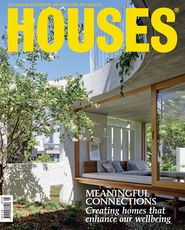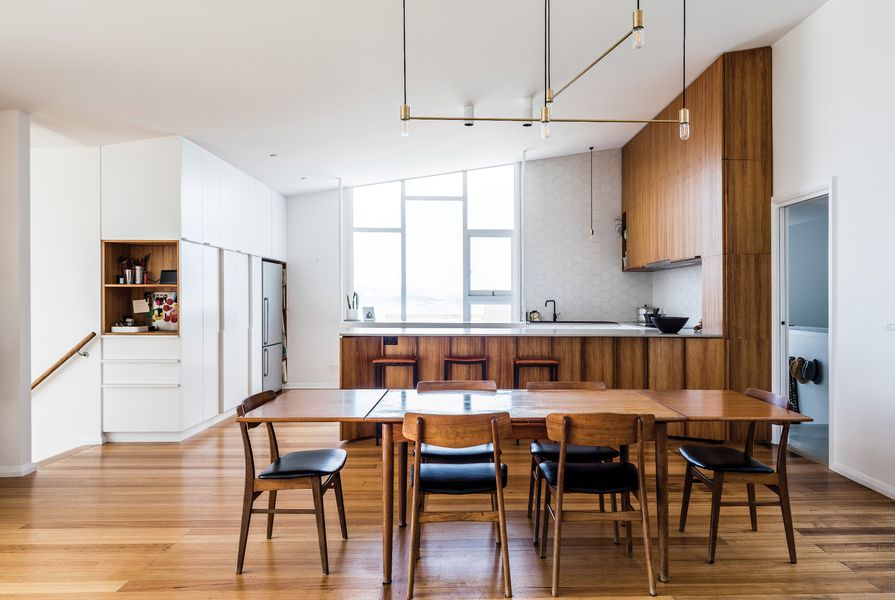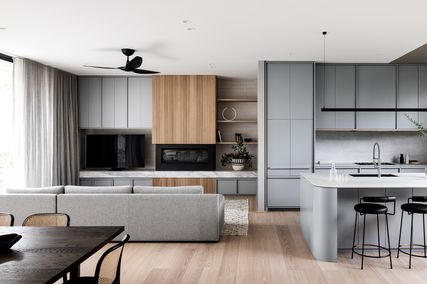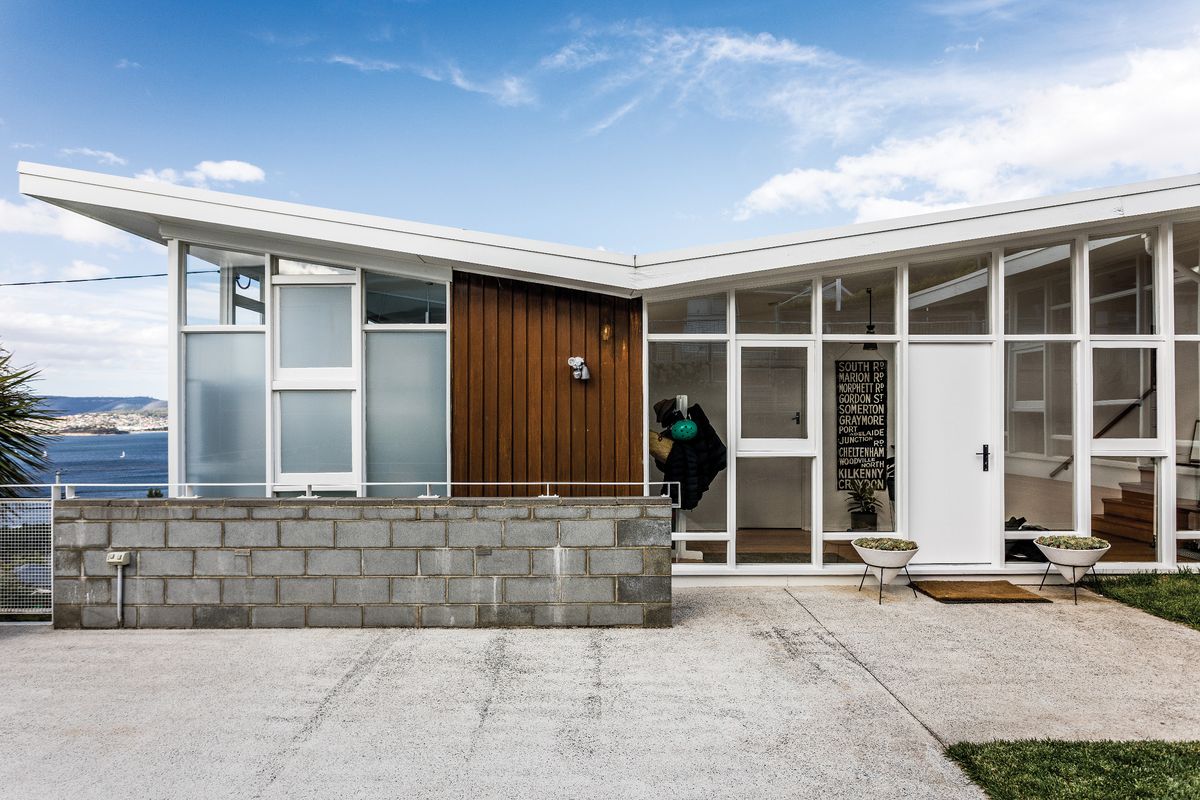What happens when owners and architects enter into a “conversation” with a mid-century modern home? In 1949, Dr Edith Emery (1909–2004), an Austrian émigré and polymath (she was a physician, teacher, linguist, writer, traveller and artist), embarked on training and a new career in architecture. From the late 1950s she designed various buildings, including a house in Tasmania for her family (1958). Located on a hillside in Sandy Bay, overlooking Hobart’s Derwent estuary, Emery’s house was designed in a modernist mode, embracing the movement’s rationalist and humanist dimensions. Logics of site, plan, material and construction framed light, bright, warm and, importantly, affordable spaces for living. A butterfly roof gave it a figurative uplift.
The original modernist butterfly roof gives the light and bright house a figurative lift.
Image: Adam Gibson
In 2005, new owners made Emery’s house their home. While the couple is committed to the house’s modernist design, they needed the mores and constraints of the 1950s addressed. They commissioned Hobart architects Poppy Taylor and Mat Hinds of Taylor and Hinds Architects to rework the home for their young family, including adding more space.
Crucial to the success of this project is the “fit” between the family’s brief and the ethos of the original house in terms of ambitions, aesthetics and affordability. Poppy and Mat approached the project by studying Emery’s original drawings and closely observing the logic of the building as a source of possibilities for the new architecture. Their investigation was at the level of ideas and their approach establishes a dialogue with the old, without compromising the originality and idiosyncrasy of the new.
The white window frames of the existing house are referenced in the extension.
Image: Adam Gibson
Taylor and Hinds Architects used the circulation spine of the original dwelling to organize the new work – comprising a laundry, bathroom and additional living space – along the eastern edge of the site and, in the process, created an enclosed garden court. Within the existing house, living spaces were reworked by pushing the kitchen across the spine into a former bedroom and opening it to make a generous, light-filled living space. At the transition from the living room to the new work, the flooring changes from timber to waxed concrete. A back door, an open laundry and a bathroom are on the left and a short hallway languidly steps up the contours of the site to the new multipurpose “garden” living room. It combines a space for study, play and entertaining with a full wall that opens onto the brick terrace of the new garden court. The addition is modest in size and was built for roughly half the cost of most current architect-designed homes, yet its placement, adaptability and robust and refined finishes have a maximal impact on the working of the house: indoor and outdoor living areas are effectively doubled, with space for the family to live at ease, all within a small footprint.
The roof line of the new work follows the contours of the site and resonates with the existing house’s form.
Image: Adam Gibson
The conversation between Emery and the architects is especially revealed in the garden court. The scale of the addition is attuned to the intimacy of family life within the garden court and counterpoised against the openness of the hillside location. The brick garden terrace soon registers as a fold of the stepped brick plinth upon which the house sits. The roof line of the new work follows the contours of the site, incorporating a kick that resonates with the butterfly roof of the original house. Battened wall sheeting painted white and dark timber window reveals invert the material strategy of the original dark-stained walls and white-framed windows. Old and new reciprocate or, as Poppy and Mat describe it, the new work is an extension of the original architecture rather than simply an addition to it.
Internally, white spaces are accentuated by timber joinery and detailing. The new kitchen is defined by blackwood veneer joinery that wraps the space and folds from the wall to the bench. On the eastern wall, in front of an existing window, a timber-framed bench invites one to sit in front of the view. Hung from the ceiling, it speaks directly to the original window frame. In the garden living room, the timber of a shutter folds into a low bench seat.
The framed view of the River Derwent from the bay window.
Image: Adam Gibson
Places in the view are important in this house. When it was her home, Emery would sit in the front room (her studio, now the main bedroom) looking out over the River Derwent and the city of Hobart. Now, in the garden living room, a window seat is canted out from the eastern wall, recreating an intimate place to sit with the vast view, bringing past, present (and future) lives of the house together.
Edith Emery is little known in architectural circles and one of the added delights of Poppy and Mat’s design is how their engagement with her work brings her architectural career into focus. For Emery, being an architect involved “tying you to people, allowing you to make them happier, their lives fuller, let them find contentment because of a house which suited their lifestyle, temperament and purse.” (Edith Emery, A Twentieth Century Life: An Autobiography.) These are the values that Taylor and Hinds Architects has artfully reinterpreted for this family home in Hobart.
Products and materials
- Roofing
- Lysaght Klip-Lok in Colorbond ‘Surfmist’.
- External walls
- James Hardie Easylap panels in Dulux Weathershield half-strength ‘Surfmist’.
- Internal walls
- CSR Gyprock plasterboard in Dulux Wash and Wear ‘Natural White’.
- Windows and doors
- Tasman Windows and Joinery Western red cedar windows and doors in Sikkens Cetol stain in ‘Walnut’; Centor bifold doors; Truth Hardware hardware.
- Flooring
- Concrete with steel trowelled finish, burnished and waxed.
- Lighting
- Anaesthetic Constellation, Bezel and Bala pendants.
- Kitchen
- Bosch oven; Smeg cooktop; Fisher and Paykel fridge and dishwasher; Euromaid rangehood; Phoenix Vivid Slimline tapware in matt black; hexagonal tiles from Academy Tiles; Caesarstone benchtop in ‘Raw Concrete’; blackwood veneer to joinery.
- Bathroom
- Phoenix Vivid Slimline tapware in matt black; hexagonal tiles from Academy Tiles.
Credits
- Project
- Longview Avenue Garden Room
- Architect
- Taylor and Hinds Architects
Hobart, Tas, Australia
- Project Team
- Mat Hinds, Poppy Taylor, Jordan Davis
- Consultants
-
Builder
Dean Scurrah Builders
Engineer JSA Consulting Engineers
- Site Details
-
Location
Hobart,
Tas,
Australia
Site type Suburban
Site area 847 m2
Building area 187 m2
- Project Details
-
Status
Built
Completion date 2016
Design, documentation 12 months
Construction 9 months
Category Residential
Type Alts and adds, New houses
Source

Project
Published online: 19 Dec 2017
Words:
Stuart King
Images:
Adam Gibson
Issue
Houses, October 2017



























